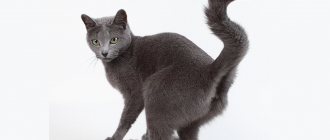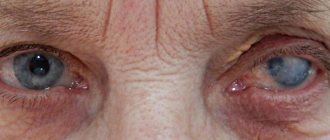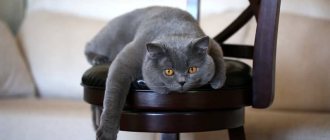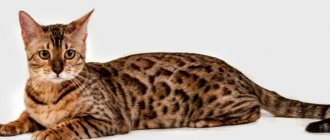When a cat develops mucus in the eyes, this is not always a signal of the development of any disease. In some cases, this phenomenon indicates spontaneous cleansing of the animal’s visual organs. However, it is necessary to distinguish when a cat has mucus in the eyes - it is a natural process, and when it is a pathological process. Since in the first case there is no need to do any special manipulations, in the second case you will need to consult a specialist.
Norm
Mucus in a cat's eyes is part of the mechanism for cleansing the organs of vision from dust and other pollutants. A cat has sharper vision than a human. It is due to evolution and helps her survive in the wild. Thanks to their good eyesight, cats are famous for being excellent hunters even in the dark. It also helps them recognize danger in time and respond quickly.
The animal’s body itself provides special care for the eyes. The released liquid helps not only to moisturize, but also to eliminate dust particles and small debris. Normally, a sufficient amount of tear fluid is formed in the lacrimal lake, from where it enters the lacrimal sac through the lacrimal openings (they act as a kind of pump). From the lacrimal sac, through the nasolacrimal duct, fluid from the eyes enters the nose, then into the nasopharynx and mouth, after which it is swallowed.
If any component of this mechanism is disrupted, the animal experiences a pathological accumulation of tear fluid, which can lead to visual impairment.
Normal mucus secretions in an animal look like this:
- they are transparent or translucent;
- have no odor;
- there are not many of them, and they do not lead to sour eyes;
- they have a semi-liquid consistency.
Sometimes you may notice an excess amount of mucus in the corners of your animal's eyes after sleep. However, this is not a pathology and the animal can cope with this phenomenon on its own during hygiene procedures.
Discharge from the eyes in cats: causes
There are infectious and non-infectious causes of eye diseases.
Among the non-contagious ones, the following are distinguished:
- mechanical injuries;
- allergy;
- hair getting into the eyes of long-haired cats;
- inversions of the eyelids of Rexes and Sphinxes;
- chronic diseases of the kidneys, liver, digestive organs, diabetes;
- tumors.
Among contagious diseases, we most often have to deal with the following infections or infestations:
- Panleukopenia;
- Calcivirosis;
- Rhinotracheitis caused by herpes viruses;
- Cat flu is a combination of calicivirus and herpes;
- Chlamydia;
- Toxoplasmosis;
- Helminthiases.
Be sure to read:
What to do if your cat has difficulty swallowing food? Swallowing disorder (dysphagia) in cats
If your pet's eyes are running and no additional symptoms are found, you can try to solve the problem yourself. The most common and affordable way to eliminate the problem is to apply tetracycline eye ointment under the eyelid, which can be purchased at a medical pharmacy.
Washing with folk remedies is acceptable, but ineffective. Therefore, cat owners should have ophthalmic drops in their first aid kit.
Ofthalmosan was developed based on centuries of experience in the use of medicinal herbs. To enhance the therapeutic effect, we added the antiseptic Chlorhexidine and an energy metabolism accelerator - succinic acid, which is formed in the body.
Instead of medicinal herbs, the drug Diamond Eyes used taurine, an amino acid that increases visual acuity. The drops are applied to the conjunctiva and dried with a gauze pad that does not contain lint.
Medicinal solutions can be used for regular preventive instillation into the eyes or nose. If there is no improvement the next day, or if additional pathological symptoms appear, the pet should be taken to the clinic. You need to be careful when treating cat eyes. Microorganisms that cause inflammation of cat's eyes are unsafe for human vision.
Breed Features
Another variant of the norm for increased mucus secretion in cats is determined by the breed. This feature occurs in cats with a flattened muzzle. This characteristic is accompanied by disruption of the nasolacrimal duct and nasopharynx. As a result, the outflow of fluid worsens and excessive accumulation occurs in the organs of vision.
Prominent representatives of these breeds are:
- "Persians";
- "British";
- Exocote;
- Scottish Fold (Scottish Fold cat);
- Manul;
- Himalayan cat.
In addition to increased mucus accumulation, these cats may experience problems associated with nasopharyngeal congestion. Snoring, frequent snorting and noisy eating are not uncommon manifestations in these breeds. Owners should carefully care for their pets and prevent the development of a pathological condition. Regular visits to the veterinarian will be helpful for this.
Our services in ophthalmology
The administration of CELT JSC regularly updates the price list posted on the clinic’s website. However, in order to avoid possible misunderstandings, we ask you to clarify the cost of services by phone: +7
| Service name | Price in rubles |
| Appointment with an ophthalmologist (primary) | 3 900 |
| Comprehensive OCT examination of the retina (one eye) | 3 500 |
| Ultrasound scanning of the anterior segment of the eye | 1 000 |
| Revision of the vitreous cavity | 44 000 — 70 000 |
All services
Make an appointment through the application or by calling +7 +7 We work every day:
- Monday—Friday: 8.00—20.00
- Saturday: 8.00–18.00
- Sunday is a day off
The nearest metro and MCC stations to the clinic:
- Highway of Enthusiasts or Perovo
- Partisan
- Enthusiast Highway
Driving directions
Signs of pathology
The first symptom of the development of a disease or various disorders is a change in the nature of the discharge. It changes color, consistency, and an unpleasant odor may appear. In this case, the development of the disease in the animal can be suspected.
Brown mucus in the eyes of a Persian cat
Depending on the physical characteristics of the fluid, a specialist will be able to determine the type of pathology. To make a more accurate diagnosis, an examination will be required. The main signs of pathological exudate that goes beyond the norm include:
- purulent discharge of beige, yellow, light brown or light green color (with or without an unpleasant odor);
- cloudy liquid with a thick consistency;
- milky mucus;
- brown or red exudate;
- a significant increase in the amount of mucus secreted with reddening of the proteins, accompanied by frequent blinking.
Important! Identifying the cause of the disease and eliminating it must be entrusted to a specialist. If not treated correctly, the disease will progress, which can lead to loss of vision.
Diagnosis of possible diseases
Before prescribing treatment, the veterinarian conducts a general clinical examination of the patient, collects anamnesis and prescribes a number of laboratory and instrumental tests. It is important to identify the main cause that triggers the appearance of brown discharge from the eyes. Only in this case is it possible to prescribe adequate treatment that gives positive results.
Diagnostic tests to determine the factors that provoked the appearance of pathological discharge from the eyes of an animal are as follows:
- general clinical blood test;
- scraping from the cornea;
- bacterial culture of separated exudate on nutrient media to determine the sensitivity of pathogenic microorganisms to certain antibiotics.
If there is a suspicion of blockage or compression of the nasolacrimal duct by neoplasms, an x-ray examination is performed. Specific testing methods, such as polymerase chain reaction and immunofluorescence assays, may also be required.
Symptoms of anxiety
If any abnormality occurs, the cat owner will immediately see changes in the quality of the fluid released. In order not to aggravate the animal’s condition and not to miss a serious illness, you should contact a specialist as soon as possible if you have the following symptoms:
- the amount of discharge has increased significantly and does not go away within several days;
- the animal has permanent crusts under the eyes;
- the fur around the eyes is wet or has dried mucus;
- the pet constantly washes itself and rubs its eyes;
- other signs of the disease occur: loss of appetite, lethargy, changes in behavior.
Treatment of eye discharge in cats
The veterinarian examines the pet and collects anamnesis. The responsible felinologist keeps a diary of observations of the pet. The records help the doctor make a correct preliminary diagnosis and prescribe treatment.
To make a final diagnosis, swabs are taken from the affected organs. Bacteriological research is not a quick process, but if it is waited, the animal may die, so treatment is prescribed immediately, and the research results will help adjust therapeutic procedures.
The need to use antiviral and antiseptic drugs is determined by a veterinarian. The cat owner will have to carry out therapeutic procedures independently after brief instructions from a veterinarian.
The following drugs are in demand:
- Anandin;
- Leopard;
- Iris;
- Dekta-2;
- Maxidin;
- Optimmune.
Causes
Pathologies that are accompanied by increased lacrimation in a cat are usually associated either with a violation of the passage of tears through the nasolacrimal duct, or with an increase in tear production.
Disruption of the lacrimal system, which impedes the normal passage of fluid, is most often caused by the following factors:
- congenital and acquired stenosis of the lacrimal openings (as a result, the tear fluid does not leave the lacrimal lake in the required quantity and accumulates there);
- narrowing of the nasolacrimal duct;
- consequences of conjunctivitis, which can lead to blockage of the nasolacrimal duct;
- dacryocystitis (infection of the lacrimal sac);
- neoplasms of various types or inflammatory processes in the head area that affect the lacrimal system;
- ingress of foreign bodies blocking the normal flow of fluid;
- plugs of mucus, which are a consequence of the disease.
Increased exudate production may occur in the following situations:
- inflammatory processes in the eyelid area;
- turning of the eyelids;
- conjunctivitis of various types;
- keratitis or inflammation of the cornea;
- abnormal growth of eyelashes and hair around the eyes (trichiasis, districhiasis);
- allergic reaction;
- glaucoma;
- external irritants (shampoos, litter tray mixture, building materials, etc.).
Treatment of the disease
If you have a question about how to treat your cat, you need to contact the clinic. The doctor will examine and interview the animal owner. Fluid may be collected from the tear glands for testing. This allows you to identify the strain of bacteria and select an effective drug. Depending on the causes of the disease, anti-inflammatory drugs and antibiotics can be used. In advanced cases, surgery is performed. Surgery may involve removing the eye, widening the tear ducts, removing a foreign object, etc.
If visiting a veterinarian is not possible, you can administer first aid to improve the condition yourself. It is recommended to use chamomile decoction for rinsing. It is prepared from pharmaceutical raw materials and distilled water. It is important to use clean liquid, otherwise the eye may become infected.
For rinsing you will need a cotton pad. It is recommended not to use gauze or standard cotton wool, as particles may remain on the surface. Rough fabric can damage delicate mucous membranes. A cotton pad is moistened in the liquid and gently wiped from the inner corner to the outer corner. If there are crusts, do not roughly remove them. You should soak the accumulations, then try to carefully remove them.
Both eyes need to be treated. A separate swab is used for each to prevent transmission of infection. It is allowed to use antibacterial solutions for treatment after permission from a veterinarian.
Prevention
By nature, a cat is capable of independently caring for itself and its health. If your pet leads a clean lifestyle, and his eyes begin to become inflamed, then the source of the infection is in your home. The exception is when the animal has free access to the street.
In any case, if there are animals in the house, frequent and thorough cleaning is necessary to avoid introducing infection into the body of your pets.
If for some reason the cat is not able to clean its eyes and face on its own, then this concern falls on your shoulders. Veterinary stores sell special lotions to clean the eyes of animals. They need to be used daily.
A real owner takes great care of his pets. He takes them to all the necessary vaccinations, prevents various diseases and monitors the cleanliness of the house.
Follow our advice, and your pets will have excellent health!
This article has been checked and approved by a veterinarian. Knyazeva Anna Vladimirovna, veterinarian in private practice, Moscow. more about the expert.
(you can vote for the article)
Tags: cat discharge, cat health, cat
- Related Posts
- Why might a cat's tooth fall out?
- A cat has discharge: which ones to be afraid of and which ones are normal?
- What does yellow discharge in a pregnant cat mean?
What is adenovirus infection?
Having found out that adenoviral infection is a type of acute respiratory viral infection, we should consider it in more detail.
The main portal of infection is the upper respiratory tract, and less commonly the conjunctiva of the eyes. It has been noted that the virus multiplies at tremendous speed, easily penetrates the blood from the affected area and spreads further throughout the body. In addition to blood vessels, adenoviruses can use lymph nodes and lymphatic tracts as a road.
The causative agent is a virus containing a DNA molecule. The infection lingers on the mucous membranes of the respiratory system and descends below, affecting the intestines. Quite often, lymphoid tissue is infected. The conjunctiva of the eyes also suggests that adenoviruses may be the culprit2.










